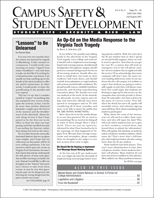Cyberstalking: An Increasing Problem for Colleges and Universities
Author: Ralph Gerstein.; Lois Gerstein .
Source: Volume 12, Number 03, Spring 2011 , pp.51-60(10)

< previous article |next article > |return to table of contents
Abstract:
Technological advances have provided an opportunity for some to stalk their victims by using electronic communication, known as “cyberstalking.” The term “cyberstalking” is difficult to define. All sources recognize the definition as stated in the 1999 Report on Cyberstalking from the U.S. Department of Justice (1999), which involves “the use of the Internet, email or other electronic communications to stalk another person,” but it can take many forms, some of which include sending an angry, hostile, or harassing email, or spreading lies in an Internet chat room where the victim is powerless to control the message being transmitted. Cyberstalking, as is the case with stalking, is also characterized by repeated harassment and threatening actions targeted at a specific individual. Tyler Clementi, who attended Rutgers University and was a promising musician, committed suicide in September 2010. Clementi was distraught over the fact that his roommate, Dharun Ravi, and a friend of Ravi's, used a webcam to record Clementi in a gay sexual encounter and then streamed it onto the Internet. Although no cyberstalking charges were brought, some commentators have suggested that the accused students could be charged with cyberstalking. The CSSD editors decided to find out more about cyberstalking and report on it to our readers. In researching the law, we understand now why cyberstalking charges were not brought in this case.Keywords: (N.J.S.A. 2C:14-9. 1.c); First Amendment; Federal Interstate Stalking Punishment and Prevention Act.; stalking; cyberbullying
Affiliations:
1: CSSD Editor; 2: CSSD Editor.